The AMD A8-7670K APU Review: Aiming for Rocket League
by Ian Cutress on November 18, 2015 8:00 AM ESTGaming Benchmarks: Low End
To satisfy our curiosity regarding low-power gaming, as well as dual graphics arrangements, we ran our regular suite through each processor. On this page are our integrated graphics results, along with a cheaper graphics solution in the R7 240 DDR3 and, in the case of AMD, both of these together in dual graphics mode.
Alien: Isolation
If first-person survival mixed with horror is your sort of thing, then Alien: Isolation, based off of the Alien franchise, should be an interesting title. Developed by Creative Assembly and released in October 2014, Alien: Isolation has won numerous awards, ranging from Game Of The Year to several top 10s/25s and Best Horror titles, ratcheting up over a million sales by February 2015. Alien: Isolation uses a custom-built engine that includes dynamic sound effects and should be fully multicore enabled.
For low-end graphics, we test at 720p with Ultra settings, whereas for mid- and high-range graphics, we bump this up to 1080p, taking the average frame rate as our marker with a scripted version of the built-in benchmark.

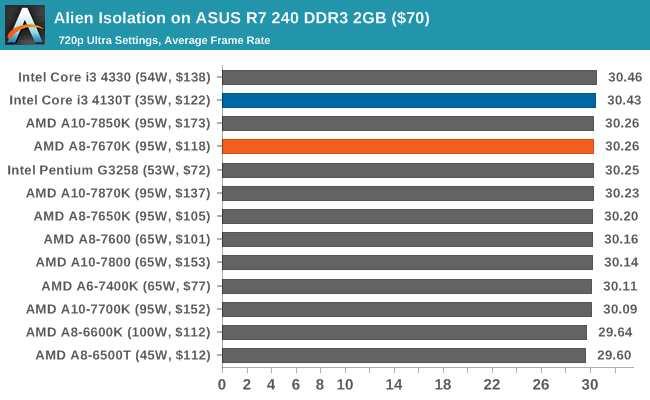
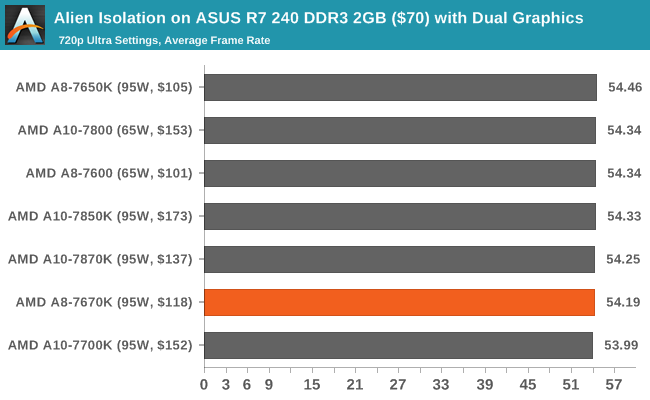
Total War: Attila
The Total War franchise moves on to Attila, another Creative Assembly development, and is a stand-alone strategy title set in 395AD where the main story line lets the gamer take control of the leader of the Huns in order to conquer parts of the world. Graphically, the game can render hundreds/thousands of units on-screen at once, all with their individual actions, and can put some of the big cards to task.
For low-end graphics, we test at 720p with performance settings, recording the average frame rate. With mid- and high-range graphics, we test at 1080p with the quality setting. In both circumstances, unlimited video memory is enabled, and the in-game scripted benchmark is used.
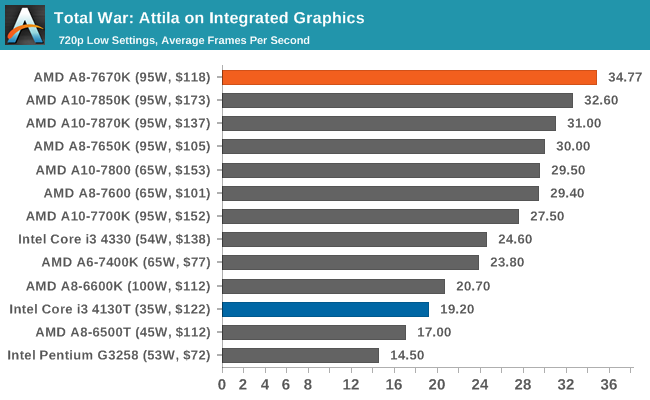

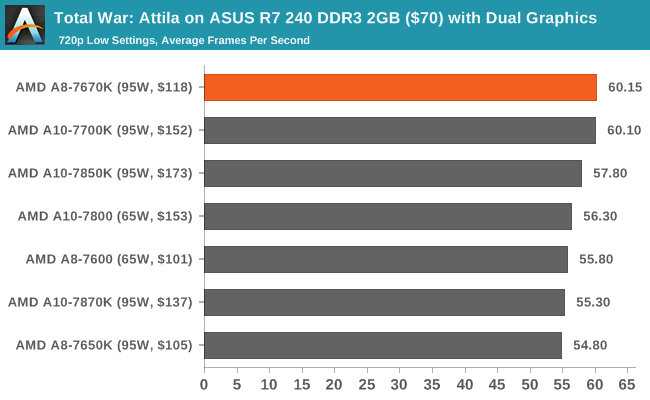
Grand Theft Auto V
The highly anticipated iteration of the Grand Theft Auto franchise finally hit the shelves on April 14, 2015, with both AMD and NVIDIA in tow to help optimize the title. GTA doesn’t provide graphical presets, but it opens up the options to users and extends the boundaries by pushing even the hardest systems to the limit using Rockstar’s Advanced Game Engine. Whether the user is flying high in the mountains with long draw distances or dealing with assorted trash in the city, when cranked up to maximum, it creates stunning visuals but hard work for both the CPU and the GPU.
For our test, we have scripted a version of the in-game benchmark, relying only on the final part, which combines a flight scene with an in-city drive-by, followed by a tanker explosion. For low-end systems, we test at 720p on the lowest settings, whereas mid- and high-end graphics play at 1080p with very high settings across the board. We record both the average frame rate and the percentage of frames under 60 fps (16.6 ms).

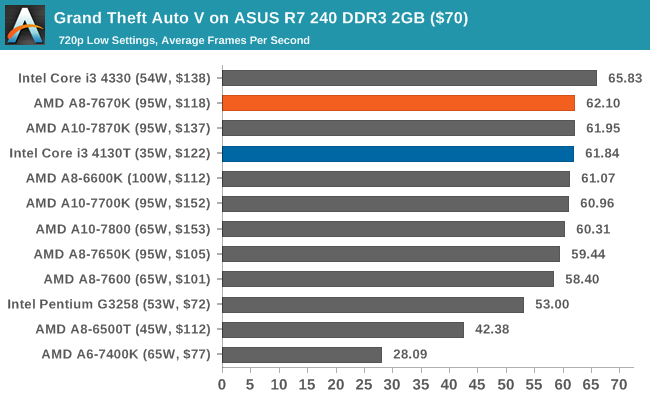
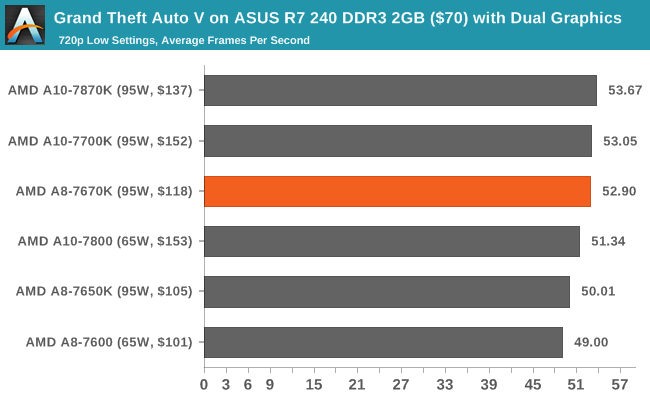
GRID: Autosport
No graphics test is complete without some input from Codemasters and the Ego engine, which means for this round of testing, we point toward GRID: Autosport, the next iteration in the GRID and racing genre. As with our previous racing testing, each update to the engine aims to add in effects, reflections, detail and realism, with Codemasters making "authenticity" a main focal point for this version.
GRID’s benchmark mode is very flexible, and as a result, we created a test race using a shortened version of the Red Bull Ring with 12 cars doing two laps. The player car is in focus throughout this benchmark and starts last, but usually finishes second or third. For low-end graphics, we test at 1080p and medium settings, whereas mid- and high-end graphics get the full 1080p maximum. Both the average and the minimum frame rates are recorded.
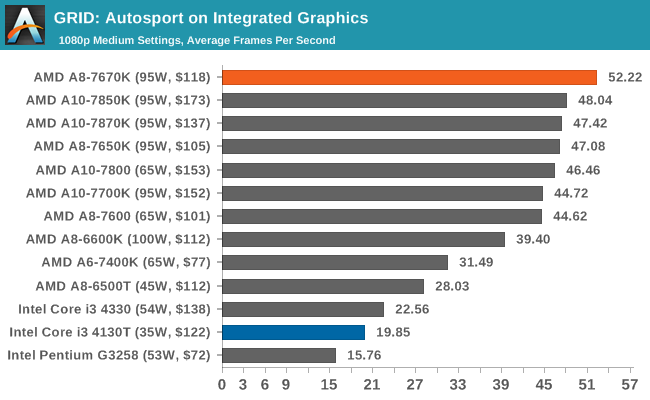
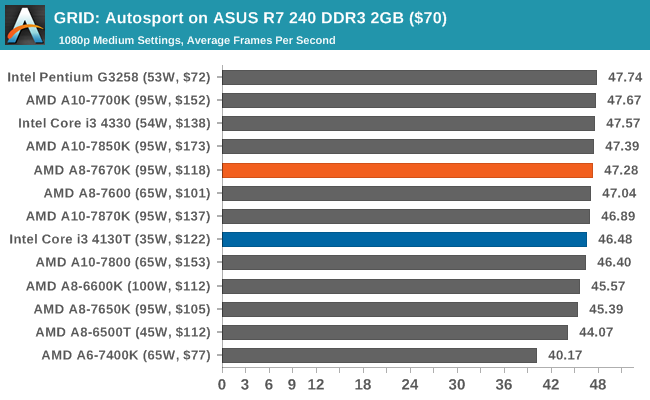
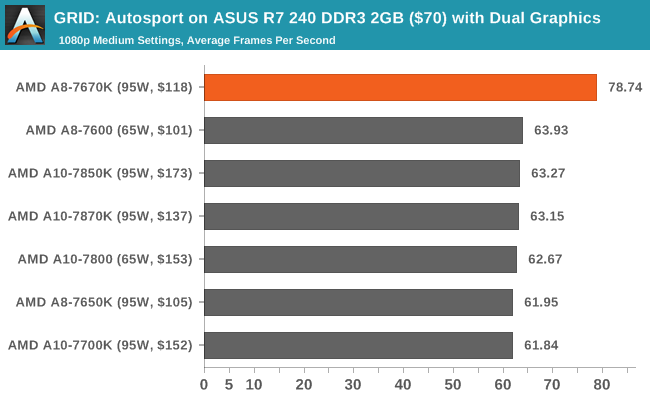
For whatever reason, the A8-7670K gets a good showing in the integrated tests, especially in dual graphics mode, with an abnormally high score. Some other issue might be at play here and warrants further testing.
Middle-Earth: Shadows of Mordor
The final title in our testing is another battle of system performance with the open-world action-adventure title Shadow of Mordor. Produced by Monolith using the LithTech Jupiter EX engine and numerous detail add-ons, SoM goes for detail and complexity to a large extent, despite having to be cut down from the original plans. The main story was written by the same writer as Red Dead Redemption, and it received Zero Punctuation’s Game of The Year in 2014.
For testing purposes, SoM gives a dynamic screen resolution setting, allowing us to render at high resolutions that are then scaled down to the monitor. As a result, we get several tests using the in-game benchmark. For low-end graphics, we examine at 720p with low settings, whereas mid- and high-end graphics get 1080p Ultra. The top graphics test is also redone at 3840x2160, also with Ultra settings, and we also test two cards at 4K where possible.
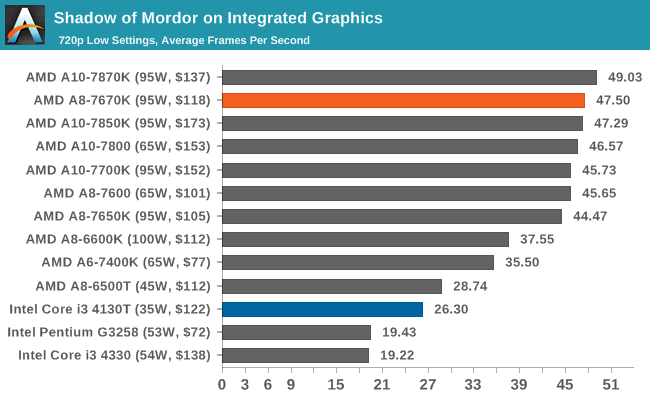
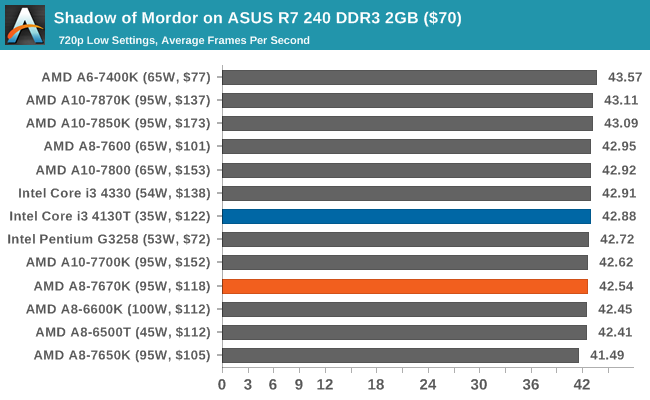
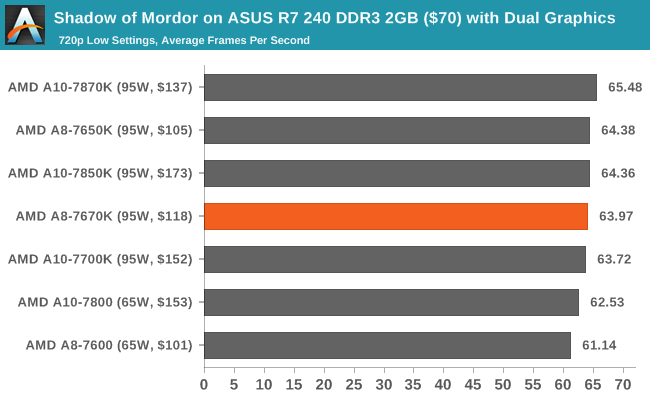















154 Comments
View All Comments
Drumsticks - Wednesday, November 18, 2015 - link
If AMD really could get a 40% single threaded performance boost on their CPUs for Zen, and they can do it no later than Kaby Lake, then they really might get a moment to breath. That puts single threaded performance right around Intel's i3 parts, and would put multi-threaded performance (and likely graphics although that's a different story) well ahead. It's not going to take back the desktop market overnight, but it would be enough to get PC builders and maybe some OEMs interested and get enough volume moving for them to survive.Even if we budget a 10% IPC boost for Intel in Kaby Lake, that puts their i3's barely ahead, and still probably significantly behind in multi threaded performance compared to a 4 core Zen part. Here's hoping for an AMD recovery! I'd love to recommend AMD parts in more than just the $300 region now. Even if Zen only gets a single OEM to genuinely notice AMD, it will be an improvement.
V900 - Wednesday, November 18, 2015 - link
You seriously think AMD is going to sell a 4 core Zen processor for the same amount that a dual core Intel i3 sells for?In that case I got a bridge to sell you!
Make no mistake, AMD doesn't sell cheap APUs out of the goodness of their hearts.
The reason they're the budget option is because they don't have anything remotely competitive with Intel's Core CPUs, and therefore only can compete on the very low end of the market.
If their Zen core turns out to be on par with an intel processor, they'll sell it at the prices Intel charges, or slightly lower.
You won't see a quadcore Zen selling for roughly the same price Intel charges for an I3. You'll have AMD selling their quadcore Zen for the same 300$ Intel charges for an i5
yankeeDDL - Wednesday, November 18, 2015 - link
I don't fully agree.Yes, AMD's IPC is much lower than Intel's, and there's a gap in energy efficiency (although, much reduced with Carrizo).
But, as you correctly indicate, AMD prices they chip accordingly. So at ~120usd, the A8/A10 are extremely attractive, in my opinion. For home users, which have the PC on on a relatively small fraction of the time, having more cores, and an excellent GPU (compared to intel's at those price point) is quite beneficial.
Skylake changes things a bit, but up to Haswell (included) the performance of Intel's Core i3 in the low $100s, was easily beaten.
Dirk_Funk - Wednesday, November 18, 2015 - link
I don't think he/she said a single word about how zen would be priced. I don't know why you responded this way. Also, i5 sells for like $200-$250.Aspiring Techie - Wednesday, November 18, 2015 - link
If Zen is as good as advertised, then AMD can afford to increase the price of their CPUs by 20%. This would make their quad-cores in the $130-150 range, way cheaper than Intel's i5s. Granted, even Zen won't be as good as Kaby Lake. If AMD's performance per clock is 60% of Intel's, then Zen's will be about 84% of Intel's. Add in that a much better power efficiency (because the microarchitecture will have fewer pipeline stages) and possibly more cache with the smaller process node and you get roughly 85% i5 performance for $30 less. This doesn't even consider their APUs, which still could be priced at near i3 levels. They would beat the crap out of i3s and sometimes i5s (if HSA is utilized).Bottom line: Zen is AMD's last chance. AMD probably won't make the stupid mistake of pricing their CPU's too high. If they do, then bye-bye AMD for good.
JoeMonco - Wednesday, November 18, 2015 - link
"Bottom line: Zen is AMD's last chance. AMD probably won't make the stupid mistake of pricing their CPU's too high. If they do, then bye-bye AMD for good."Because if AMD is known for anything it's for its great business decisions. rofl
medi03 - Thursday, November 19, 2015 - link
Yeah, that's why they are in both major consoles at the moment, because of the "bad" business decisions.Klimax - Thursday, November 19, 2015 - link
There's a reason why Intel was uninterested in consoles. AMD barely makes any money on them...Kutark - Thursday, November 19, 2015 - link
^ This. Being in the consoles is because it was a massive volume order of parts and MS and Sony are looking to save as much as possible, fractions of a dollar per part matter when you're paying for literally millions of parts.anubis44 - Sunday, November 29, 2015 - link
The consoles are still providing AMD with a solid, baseline income every year, and their presence in consoles also make games easier to port to AMD's architecture, something that will become more apparent with DX12, since consoles are already using a DX12/Mantle-like API. AMD's decision to sweep the consoles and push Intel and nVidia out of them will have longer term reprocussions than many realize. AMD is also almost certain to win the next generation of consoles, too, with Zen-based APUs and Greenland-type graphics with HBM. In fact, AMD will probably release something like that for the mainstream PC market by 2017 and nVidia will be relegated to only the high-end of add-in graphics: AMD will be putting solidly mainstream graphics into their APUs, and an add-in mainstream AMD card will simply crossfire with the built-in graphics.